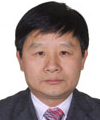doi:10.3850/978-981-07-7136-2_299
Main Issues on Seismic Resistance of Steel Frames Coupled with Concrete Core for Tall Buildings
Professor Guo-Qiang Li
State Key Laboratory for Disaster Reduction in Civil Engineering and College of Civil Engineering
Tongji University, China 200092
Email: gqli@tongji.edu.cn
Biography
 Prof. G. Q. Li is currently a professor of structural engineering at the College of Civil
Engineering in Tongji University and the director of Research Centre of Education
Ministry of China for Steel Construction. He is a vice-chairman of China Association of
Construction Standardization, the Chairman of China Association for Fire-Resistance of Steel Construction
and the country representative of China for Council of Tall Buildings and Urban Habitat. He is the director for
the committee for Accreditation of Higher Education for Civil Engineering in China and the director of the
steering committee of Civil Engineering Education of China. He is also a fellow of Institution of Structural
Engineers in UK, an Honorary Fellow of Hong Kong Institute of Steel Construction and the first class
Professional Engineer in China.
Prof. G. Q. Li is currently a professor of structural engineering at the College of Civil
Engineering in Tongji University and the director of Research Centre of Education
Ministry of China for Steel Construction. He is a vice-chairman of China Association of
Construction Standardization, the Chairman of China Association for Fire-Resistance of Steel Construction
and the country representative of China for Council of Tall Buildings and Urban Habitat. He is the director for
the committee for Accreditation of Higher Education for Civil Engineering in China and the director of the
steering committee of Civil Engineering Education of China. He is also a fellow of Institution of Structural
Engineers in UK, an Honorary Fellow of Hong Kong Institute of Steel Construction and the first class
Professional Engineer in China.
He has been in involved in research and practice in steel structures covering a wide spectrum of interests, including advanced analysis and design of structures subject to earthquakes, fires and explosions. He has authored or co-authored 13 technical books and published more than 450 journal papers in either Chinese or English. He serves on the editorial boards of 7 international journals and 12 national journals of China. He is the leading or a key person responsible for the development of 14 Chinese Codes relevant to the design and construction of steel structures.
Abstract
The application of hybrid structures consisting of steel frames and concrete cores for tall buildings in earthquake zones is questionable due to damage cases occurred and insufficient researches. This paper presents three main issues on the seismic resistance of hybrid tall buildings. These include the difficulties of forming dual lateral force resisting system, load-bearing capacity of steel-beam-to-concretewall (SBCW) connections and inter-storey drift limitation of hybrid structures. The corresponding solution methods have been investigated by experimental and analytical studies at Tongji Univeristy. The collaboration between steel frames and concrete cores can be improved by enhancing the ductility of the concrete core by reinforcing shear walls with steel or steel plate for the concrete core. Experiments have been carried out to study the ductility of steel reinforced concrete shear walls. Additional forces induced by earthquakes in the SBCW connections are investigated, and three full-scale experiments were conducted to study the load-bearing capacity of SBCW connections. A formula to calculate the allowable harmful inter-storey drift for hybrid tall buildings was deduced which was ranged between 1/1000 and 1/6000. A 1/20 scaled 25-storey hybrid tall building model was tested on the shaking table to study the overall seismic resistance of hybrid structures. The top lateral deflection over 1/45 of the total height of the model was observed under high-level earthquakes. This indicates that the hybrid structures consisting of steel frames coupled with steel-enhanced concrete core may possess good ductility to resist earthquakes.

